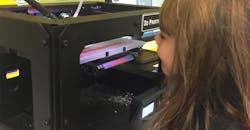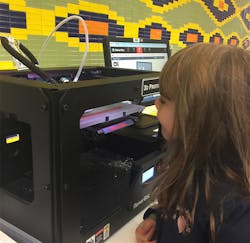My kid, like half the other girls at her school, wanted to be Hermione Granger—queen nerd of the Harry Potter world—for Halloween this year. In the past, this would have meant a lot of work to pull off. A lot of thrift store shopping, a lot of handsewing, a lot of approximations of Gryffindor colors, crests, and details.
But this is the future, so every part was easily available on Amazon. I bought the whole outfit from crested robes to official Gryffindor tie in 30 seconds on my phone while waiting in line at the grocery store. Which is exactly how the future is supposed to work, I think.
The only problem was the wand. Not that there's any lacking of Hermione wands on the web. They are preposterously expensive, detailed, hand-carved wooden versions. And there is the expensive, but not preposterously expensive, light-up version that her best friend at school has been showing off about for weeks. That would've cost more than the rest of the outfit and all of the candy combined. And then, of course, there's the cheap plastic version. But, because it's the future, I knew that that one was no good. Reviews on Amazon and every other online retailer are absolutely vicious about the thing. Too thick, wrong color, etc, etc.
Which left us wandless.
However. Because this is the future, I knew that our public library as a whole range of 3D printers just waiting to be used in it's super fancy, completely amazing public makerspace. And, because it's the future, I knew that there's a whole online marketplace of free .stl files just waiting to be plugged into idle machines.
So I grabbed the kid last Saturday, and she and I had a maker adventure. We crossed town to the main library, logged in, and found ourselves the perfect Hermione wand on Thingiverse. I taught her how to set up the machine, how to feed the filaments into the old, abused MakerBot, how to manipulate the digital files for the build to maximize efficiency. And I let her tiny fingers hit the print button.
For the next two hours, she sat transfixed, nose just inches from the deposition head, face just hardly in the safety zone. And I saw it, I saw the very moment her perspective of the world changed.
She held in her hand a tiny strand of filament, just that skinny bit of plastic that fed through as we were setting up the machine. She turned it over, looked at it, looked at the print job. She saw this tiny, gossamer thread of brown plastic in her hand was the same that was making the wand that she chose, that she helped design.
She watched nearly the entire build, unable to turn away.
She asked questions about architecture for the filling, why it was hollow in some places, how the machine worked, how the files worked. And I saw it all clicking.
We went online, found other things that she wanted to print, found other projects that she wanted to make, other adventures in design and manufacturing she wanted to explore. She was hooked. It was all the magic that any little Hermione would ever want.
The end result of all this was a plastic wand. Detailed, but, you know, MakerBot detailed. Glued together in four places and looking as sophisticated as any 3D printed toy can look.
The whole build cost us $0.05.
But for her, it was everything. It beat those fancy wood carved models, it beat her best friend's fancy glowing thing. It was hers. She built it. She made it. She took it to school proudly, where she showed her friends, explained the whole 3D printing process to anyone who would listen.
"I made it out of nothing," she told them. She made it out of nothing.
And this, I suppose, is the future. Children who know nothing about design, nothing about machines, can build the toys of their dreams out of nothing.
That's just the start point. It only gets more exciting from there.
About the Author
Travis Hessman
VP of Content, Endeavor Business Media
Travis Hessman is the VP of Content for Endeavor Business Media. Previously, Travis was the Editor-in-Chief for Industry Week and New Equipment Digest as well as the Group Editorial Director for Endeavor's Manufacturing Group.
He began his career as an intern at IndustryWeek in 2001 and later served as IW's technology and innovation editor. Today, he combines his experience as an educator, a writer, and a journalist to help address some of the most significant challenges in the manufacturing industry, with a particular focus on leadership, training, and the technologies of smart manufacturing.


